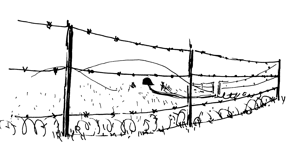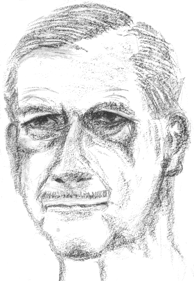

Home, Introduction, Chapter 2, Chapter 10
The Story So Far: South Bandicoot flourished during the gold rushes, although in some circles the arrival of the Raffertys was not seen as an unmixed blessing. It then declined into a rural backwater, being bypassed by the railway (which instead went through Gurrangi, 50km away), although not before the Royal Hotel had changed its name to the Railway Hotel. It did achieved local government in 1881, with Edward Clark's watch chain doubling as the Mayoral Chain and Fergus Rafferty being appointed Shire Clerk. In 1907, Bandicoot Shire being ranked third on the list of corrupt councils. An impressive timber truss bridge was built across One Mile Creek.

The War Memorial
Like every Australian small town, South Bandicoot has an almost complete list of its adult male population in 1914 carved into a granite pillar located in a prominent position — in this case at the top of a mullock heap 50 metres from the Clark Street intersection. Reading the list, one wonders how names like Clark and Rafferty could ever have survived, until one is told that 2nd Lieutenant Cavendish Clark married his childhood sweetheart Elizabeth Hume a week before his departure, and that a bonny, bouncing boy arrived many months after the dreaded telegram from the War Office; and until one realises that the decimation of a population of Raffertys merely leaves the survivors hardier and more fecund than ever.
The roll for World War 2, Korea and Vietnam yields more names: Donoghue, Fraser, Ferrari, Drosic, Wang, and many others, not in such quantity, perhaps, but more in variety.
At the base of the pillar, there are two more names. On the plinth, almost obscured by the occasionally tended grass, is a small plaque:
To those, from distant foreign shores,
who made the supreme sacrifice in the
defence of our land:
Lt. C.H. McLeod
Sgt. R. Raratonga
17th R.N.Z.E.
7th June, 1942
Contemporary accounts, and many more recent histories, are strangely silent as to the true extent of Japanese incursions against the Australian mainland. Until recently, most people knew that Darwin had been bombed, but few were aware of the extent or duration of that bombing, not just in Darwin but along the whole north coast of Australia, both because of the press censorship at the time, and because of subsequent embarrassment by Australian officials and military historians. It is little wonder, then, that a total wall of silence surrounds the repulse of a Japanese invasion force by a platoon of New Zealand engineers.
Official histories also do not say how a company of New Zealand engineers came to be posted to South Bandicoot, but some of the older residents of South Bandicoot believe that they know.
During the dark days of early 1942, the Australian Government, no longer convinced about the integrity of even the Brisbane Line, was looking to build a place of refuge from which it could set up a government in exile and conduct a resistance campaign against the occupying Japanese. Canberra was considered, but eliminated as being insufficiently remote. Eventually a set of caves tucked into the west side of the Bandicoot valley was settled upon, and preparations began to fit them up in suitable luxury. However, in fear of leakages and possible mutiny if Australian troops discovered what was afoot, the New Zealand government was persuaded to supply the needed personnel: a company of engineers under Captain Marcus O’Neill, an iron disciplinarian who believed in No Fraternisation with the Natives.
To say that the engineers were welcome in South Bandicoot would be an understatement, not so much because the menfolk were away (to most of South Bandicoot’s female residents, this was a matter of relief) but because the New Zealanders possessed unrivalled links to the black market for everything from washers for leaky taps to imported French gumboots, in addition to an inherited genius for keeping Captain O’Neill in the dark. Supreme among the more commercially minded New Zealanders was Rangi Raratonga, six foot high and six foot wide, prop forward for the All Blacks, and Quartermaster Sergeant. Charles Rafferty, the partner left in charge of the local medical practice while the other doctors were at war, remembers that:
If he couldn’t get it for you, no-one could. And he was generous, too: a smile here, a clap on the back there, a tube of toothpaste thrown in. Everybody loved him, except Hamish McLeod, because Hamish had his eye on Carmel Rafferty, and Rangi got there first.
Carmel, of course, just shrugs it off. "Hamish should have asked," she says, "instead of just staring, goggle eyed. He was an officer, after all."
Preparation of the caves went ahead by leaps and bounds. New tunnels and caverns were dug and fitted out with the latest in communications equipment, printing presses and hot showers, walls were scrubbed down to remove crude red and yellow ochre portrayals of bandicoots and wallabies, and piles of emu bones were shovelled out on to a forbidding heap beside the door. It was this last that gave the refuge its name: Moa Mansions.

The Top Secret Defence Installation, Moa Mansions
Survey teams were investigating routes for a proto Ho Chi Minh trail: a secret network of tracks to the coast and inland, hidden in dense bush and deep valleys, skirting civilisation and habitation alike.
In his evidence to the New Zealand Department of War’s Enquiry into the Japanese Invasion of Australia, McLeod’s batman, Private Robertson, described the genesis of further conflict between McLeod and Sergeant Raratonga.
The pile of emu bones had begun to shrink.
"What are we using them for, sir?" Lieutenant McLeod had asked Captain O’Neill, on his return from a survey, thinking that they might have discovered a new source of road metal.
"Using them?" Captain O’Neill looked real angry, the veins standing in his forehead. "You mean, someone is stealing them? Find out who, immediately."
The found out soon enough, who being Sergeant Raratonga, who was grinding them up and selling them as an ancient Maori aphrodisiac. Captain O’Neill said that a walk in the bush would do him good. We reckoned Captain O’Neill wanted time to do an audit. He instructed Hamish McLeod to take Sergeant Raratonga on his next survey.
"Is that a good idea, sir?" Lieutenant McLeod asked. "Sergeant Raratonga thinks that I dobbed him in."
"Nonsense, it’ll be good for both of you."
It was early June. The battle of the Coral Sea had been fought and won. Midget submarines had been found in Sydney Harbour. News of the battle of Midway had not yet come. And the fishing vessel Ginseng, believed now to be the notorious Japanese spy ship Sashimi Maru, was coasting unseen southwards past Bateman’s Bay.
Nerves were tense, and became tenser as the survey team inched its way down the raging Deua River, their sightlines limited by thick timber and their theodolites refusing to stand waist deep in the water. Hamish McLeod was nearly swept away when a swirling branch thumped him behind the knees. Only the presence of mind of his batman, Private Robertson, saved him. Robertson describes the scene:
McLeod turned and shook his fist at Sergeant Raratonga, who was standing on the bank, twenty yards upstream. Raratonga showed a set of very white teeth.
That night, 6th June, the team camped on two small rises, fifty yards apart, beside the river. Unless they climbed the steep hill beside them, this was all that they could find. McLeod, accompanied by his batman, and the chainman, was on one; Raratonga and his drinking mates on the other. Between the two mounds the ground was clear, but marshy, as the river widened a little, and a faint track curved along the foot of the hill; but the tents were hidden in the trees. By midnight, the camps were quiet, Raratonga’s grog supply exhausted, and the fires had burned down to nothing.
In the half light before dawn, McLeod awoke to the screeching of the birds — and something else: the scrunch of feet, and the sing-song chatter of the Japanese army. He peered out, and saw a column of yellow faces winding beneath the foot of the hill.
He grabbed his gun and screamed "It’s the Japanese!". He opened fire. The column scattered. One fell, and then began to crawl away. There was a fusillade of shots: from beside him, from the other rise, from the Japanese, echoing and reechoing against the hillside and across the valley. He staggered and fell, mortally wounded.
Within minutes it was all over. The Japanese were gone, their bodies swept away by the raging torrent, far out to sea where the sharks and the gulls had a feasting never equalled before or since.
Private Robertson comforted Lieutenant McLeod in his final moments.
"They got Rangi, too," we told him.
The ship that landed the Japanese force fared little better. According to the Sydney Morning Herald, 8th June, 1942:
A fishing vessel, believed to be the notorious Japanese spy ship Sashimi Maru, was sunk while heading out to sea off Narooma early yesterday morning. There were no survivors.
Confidential Defence Department records reveal that two aircraft were lost in the encounter, colliding in mid-air as they converged to machine-gun the survivors on their life rafts.
After the war, some local residents, including Carmel Robertson, married to a New Zealander and the proud mother of a dark-skinned child called Rangi, attempted to have the names of Lt. McLeod and Sgt. Raratonga inscribed on the war memorial. The South Bandicoot branch of the Returned Servicemen’s League opposed the proposal. In a minute to the Chairman of Bandicoot Shire Council, the branch president, Brian Kelly, wrote:
It is neither customary nor appropriate to award such recognition for service on Australian soil, in particular where, at least in my opinion, death or injury was caused by panic, careless use of weaponry and ricocheting bullets. To do so would demean the entire ANZAC tradition.
Carmel Robertson’s reply, recorded in the Council minutes, was brief and abusive. "They gave us a damn sight more pleasure than you lot of ... layabouts ever did," she is reported as having said.
A compromise was eventually reached, although not before the R.S.L. clubrooms had burned down and Granny Rafferty had put the evil eye on Kelly’s Fresians, and a plaque was attached to the base of the memorial.

Dr Charles Rafferty
However, Dr Charles Rafferty has his own personal conclusion to the story.
It’d been a stinker of a day. Half the women in the town had crook backs because their mothers didn’t teach them how to lift properly; and the other half had been at the New Zealanders and needed medical intervention so that they could look hubby in the eye if and when he got back from the war — barring the Rafferty girls, of course, who seem to regard the results just like any other souvenir.
I’d just got to my fifth whiskey, and was thinking that the world wasn’t such a bad place after all, when there was a tap-tap-tap on the back door. I went through, and there was old Sarcophagus Lee, so white that he’d get past immigration any day, and shivering.
"Please come," he said. "Three people, hurt bad."
I picked up my black bag and went with him. It was a bitter old night, but there was no point in taking the car because we’d used the emergency medical petrol ration to take Mary’s kids fishing down at One Mile Creek, so we scrunched across the paddocks, the frozen grass spearing my feet through the holes in my shoes.
We went to the outhouse where he keeps the hearse. He did his tap-tap-tap on the door, and then pushed it open a crack and we squeezed our way in.
A ring of yellow faces surrounded us, twenty or more of them, from Granny to a three year old kid.
"My cousin," Lee said. "Escape from China. Come here last night from coast. But Kiwi panic. Shoot first. No question, even after." He lifted the lamp from its hook by the door, and I saw three more of Lee’s relatives, sitting huddled and miserable.
"You fix them?" Lee asked.
Copyright © D.W. Walker, 1991